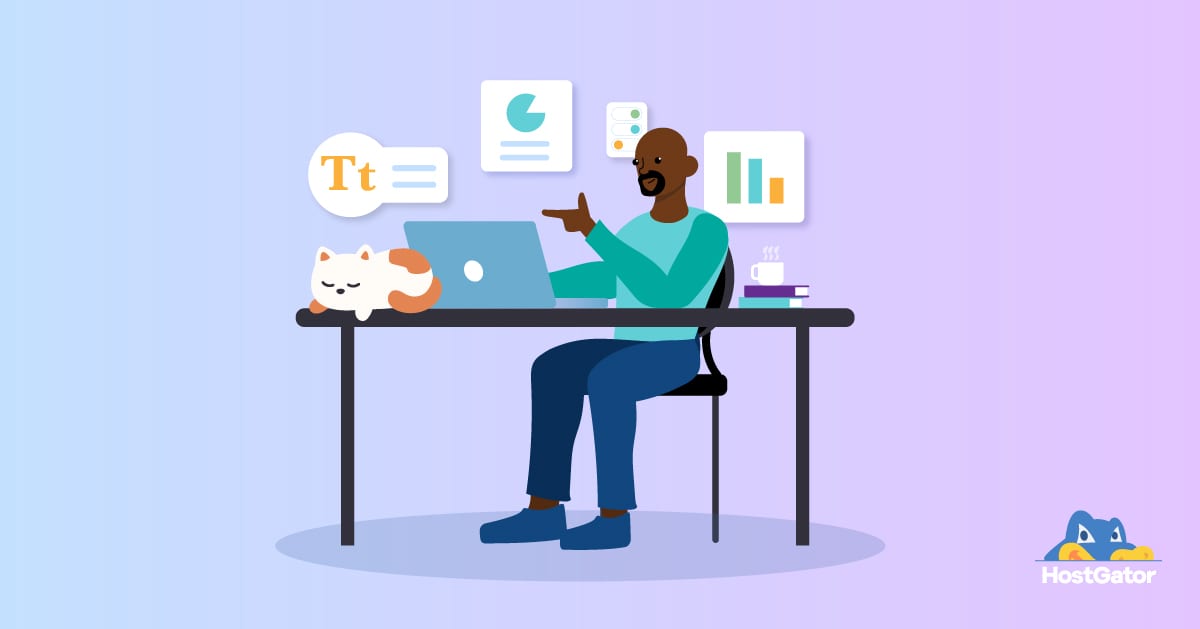Maybe you’ve been building websites for fun, and you’re darn good at it. Perhaps you’re the developer your colleagues always ask for design suggestions.
Or maybe you’ve just visited too many websites with janky layouts, fonts and UX—and you know for a fact you can design sites that are much better.
If this is you, it may be time to start your own web design business. In which case, you may want some guidance on business setup.
No worries, we’ve got you. In this post we’ll guide you through creating a plan to get your freelance web design business off the ground, so you can create a new revenue stream and set the stage for taking your web design business full-time if you want to.
Ready? Let’s start designing your new business.
Who do you want your customers to be?
It’s not a trick question, and the answer isn’t “everybody.”
Why not? Two reasons:
- You get to decide who you want to work with. It’s one of the best perks of being a freelancer. It’s also practical: As a business owner, you want to work with people who can pay rates that keep your lights on, pay on time, and can refer you to other clients like them or come back to you for more design work later on.
- Every business needs a website, but each kind of business has specific needs. For example, an eCommerce site has different design requirements than websites for hair salons, software publishers, CPAs, nonprofits, or real estate agencies.
When you pick a niche that you’re interested in and know something about, it’s easier to specialize, get more efficient at your work, and build a portfolio that appeals to the kinds of customers you want to work with.
Bonus: When you specialize in a niche, you’re going to build a portfolio that can help you move into related niches with bigger budgets. For example, let’s say you start designing websites for local residential property managers. As your portfolio grows, you might be able to attract commercial property manager clients, too. Ka-ching!
If you’ve already built sites for certain types of businesses, then that niche may be where you want to start. Starting from scratch? One approach is to find the sweet spot of businesses that are in profitable niches and that also don’t typically have great websites.
For example, NerdWallet’s current list of the most profitable SMBs includes auto repair shops, food trucks and car wash services. Traditionally, they don’t have the greatest websites. But they may have money to invest in better design to outperform their competitors and keep their growth going.
As you home in on your ideal customers, you can do more research and create personas for them. This can feel weird, but it matters, because customer personas will become the foundation of your marketing program later on.
Draft your business plan
Your business plan can be as simple or as detailed as you want it to be, as long as it contains key information about your customer base, services, pricing, marketing and revenue targets.
BTW, if you’re not sure how to price your services, the Freelancer’s Bible by Sara Horowitz includes a section that breaks down exactly how to figure out your expenses and your rates so you can have your dream job and eat, too.
Here are a few free business plan options:
- The One-Page Business Plan from The $100 Startup is fast, easy and focused on the basics.
- The Business Model Canvas is another one-page planning tool, but this one is visual—perfect for someone with a design mindset.
- Want a more substantial plan? Visit this Small Business Administration page and click See Rebecca’s Plan for an 8-page business plan template.
- Want to launch a web design startup with a loan or investor cash? You’ll need the kind of detail this 34-page SCORE business plan template provides.
Even if you’re not applying for a business loan, it’s a good idea to write down your plan so that you can refer to it and stay on target, so you’re not tempted to take on any old clients that come along.
You may already have a computer and design software that can handle commercial projects, but you’re going to need more stuff to run your business. We’re not saying buy anything new just yet (wait until you set up your business bank account), but you’ll want to build your tools list early so you can test your options, create a budget and look for good deals.
What kind of hardware will you need for your business? In addition to a computer, a good monitor or two and the usual peripherals, you may also need:
- A digital drawing tablet and stylus
- A digital SLR camera (plus a tripod, lights, a mic and a green screen)
- A scanner
- A printer
- A laptop or secondary desktop in case something goes wrong with your primary machine
- An uninterruptible power supply to save you from outage-related data loss and remote meeting interruptions
What about software and apps?
Even if you already have design software that you love, it’s worth checking out free trials of the competition to see what’s available. And design software is only one part of what you’ll need. Think about what apps or services you want to use to:
- schedule client appointments
- communicate with clients
- host video calls
- manage and share your project workflows
- handle accounting
- invoice clients and get paid
Read reviews, check out free trials, make sure you understand the pricing and find out how you can export your data if you ever decide to switch to another app or solution provider. Your future self will thank you.
Set up your web design business
You’ve got a business plan, a target customer base, and a list of the tools you need to begin. Now it’s time to make your web design business a reality, which starts with deciding what kind of business structure you want. You can get the full rundown at the SBA website, but in general your options are sole proprietorship, partnership, limited liability company (LLC) or a corporation.
At this step, it’s a really good idea to talk to a CPA or business attorney you trust, because you want to make sure you make the right choice for your situation. Going solo is faster and cheaper to get started, but you have unlimited personal liability if something goes wrong with your business. Partnerships also come with unlimited liability. LLCs and corporations cost more to set up and run, but you’re not personally responsible for debts your company incurs.
Once you know how you’ll structure your business, it’s time to:
- Register your business name with your state controller’s office, to make sure it’s not the same as another business in your state.
- Get a state tax ID for your business.
- Get an employer identification number (EIN) from the IRS website.
- Apply for your city, county or state business permit, even if you’re working out of your home.
- Research the business account options available from your bank or credit union. Most offer free or low-fee options for small businesses.
- Take your EIN from the IRS and your state or local permit to your bank or credit union and open your business checking and savings accounts. Move some money into there for business expenses so your accounting and taxes are easy to handle.
Your web design business is official! Now what?
The fun is just beginning. Use funds from your business account to
One more thing: Start using your accounting software now, to make sure you’re paying taxes on the right schedule, so you don’t get surprised by a big ol’ tax bill next April. Most self-employed people need to pay quarterly estimated taxes and file a yearly return. Check the IRS website’s Self-Employed Individuals Tax Center for the most current information.
Create your web design portfolio website
Now that your business is legal and you have the tools you need to work for clients, you need some clients. For that, you need a portfolio website that shows off your best work, whether that’s sites you’ve designed for yourself, friends or past customers.
You’re a web designer, so you probably don’t need any tips on making your portfolio look great. But to make sure you’ve got the content bases covered, you can check out our guide to creating a portfolio site.
Make your marketing plan
Just fire up social media, right? Well, kinda. You’ll get more results from your social media efforts if you plan your posts to drive traffic to your website. It also helps to create a content calendar for your social accounts and your portfolio site’s blog, if you have one, so you’re not scrambling for content or going weeks between posts.
You’ll also want to encourage site visitors to sign up for your newsletter. Set up your email management tool (like Constant Contact) to make sure they get a welcome email and all your updates.
Want to do some serious forward planning? After you have your email system set up, look for a customer relationship management (CRM) program that fits your budget and integrates with your email marketing manager.
This will seem completely over the top when you’re getting started, but you’ll thank yourself later when your web design business is growing and you have a lot of current, dormant and prospective customers you want to stay in contact with to grow your business.
Find peers and mentors
You may be a solopreneur but you’re not alone. You can learn how to run your business better with free advice from the SBA’s SCORE mentor program for small businesses. You can tap into local digital creative groups and the NYC-based Freelancers Union for details on how to manage clients, contracts and the challenges of freelance life.
That’s the process in a nutshell. Are you ready to start your web design business? Check out our Virtue Media PRO hosting plans, including our white-label reseller plans so you can offer branded hosting to your design clients.



![How to Create Your Freelance Brand [5-Step Guide]](https://mdvirtue.com/wp-content/uploads/2022/02/How-to-Create-Your-Freelance-Brand-5-Step-Guide-400x250.jpeg)
![How to Build a Coaching Website on WordPress [Expert Guide]](https://mdvirtue.com/wp-content/uploads/2022/02/How-to-Build-a-Coaching-Website-on-WordPress-Expert-Guide-400x250.jpeg)

0 Comments